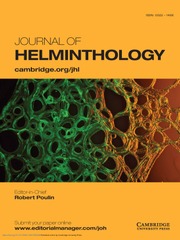No CrossRef data available.
Article contents
Recognition of Toxocara canis excretion-secretion antigens in the serum of children with epilepsy. Involvement in the diagnosis of visceral larva migrans
Published online by Cambridge University Press: 08 August 2025
Abstract
Visceral larva migrans syndrome (VLM) is caused by L2 Toxocara canis. This parasitic disease is difficult to diagnose in humans, but specific antigen identification could allow for parasite detection. The aim of this study was to analyse antigens of different parasite developmental stages and observe their cross-reactions with antigens from other parasites to determine their importance in the diagnosis of VLM caused by T. canis. Sera from 14 children with cryptogenic epilepsy previously positive for T. canis were analysed via Western blot (WB) using T. canis excretion-secretion antigens (TESs) from distinct morphological parasite stages; cross-reactivity of these antigens with antigens from other parasites were evaluated. Children sera recognized antigens from L2 T. canis TES, mainly a protein of 24 kDa. Proteins in the medium- and high-molecular-weight ranges were also detected in the egg phase. In the adult phase, only 42.9% of analysed sera recognized a protein of high-molecular weight. Cross-reaction tests identified medium and high-molecular weight proteins, mainly from L2 of Ascaris lumbricoides and Gnathostoma binucleatum and adults of Ancylostoma caninum, but none of the proteins found had crossover with low-molecular weight proteins from Toxocara canis. Antigens in the larval morphological stage of T. canis TES were recognized in the highest percentage of the analysed sera; these antigens could be used to diagnose VLM.
Information
- Type
- Research Paper
- Information
- Copyright
- © The Author(s), 2025. Published by Cambridge University Press

